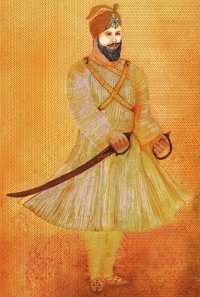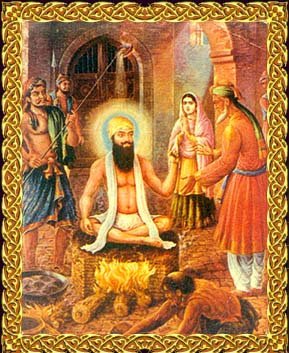Lahore: It was, at least till that point, the single most important event in the short history of the Sikhs. Not only did it change the course of Sikhism but also had long lasting impact on the course of events in Punjab. His was no ordinary death. This was the execution of a Guru, the head of this nascent religious community, a peaceful community which at that point could not, even it wanted to, threaten the mighty Mughal Empire – then at its zenith – ruled by Emperor Jahangir, conqueror of the world. This was the execution of Guru Arjan Dev, the fifth Sikh Guru.
What is also significant here is the nature of the execution. For five days, the Guru is said to have been tortured. Burning sand is said to have been poured on his head as he sat in a lit cauldron, bearing all of this peacefully. There are multiple contesting narratives as to why the Guru was executed – narratives that still inspire heated debates and arguments. It’s not my job, neither my interest here, to explore these claims. What I am rather interested in is the long-lasting impact of this execution.
It is in the shadow of his father’s execution that Guru Hargobind emerges, the first Sikh Guru who could truly be called ‘Saint Warrior’. Realising the perilous situation of the community, the sixth Guru continued with passion the process of militarising the Sikh community, for self-protection. It is really the process started by Guru Hargobind that culminated with Guru Gobind Singh, the tenth Sikh Guru.
In the popular imagination, it is Guru Gobind Singh, who is thought of as a ‘Saint Warrior’ for his opposition to Emperor Aurangzeb. However, the impact of Guru Hargobind cannot be understated on Guru Gobind Singh, with the latter even keeping the sword of his the Guru as a cherished possession.
Another interesting parallel that connects the stories of these two Gurus is the nature of their ascension. Guru Gobind Singh too became a Guru in the aftermath of the execution of his father, Guru Tegh Bahadur at the hands of Emperor Aurangzeb. There was, therefore, a similar nature of threat on the Sikh community and its future at the time of his rise.
Between Guru Arjun, Guru Hargobind and Emperor Jahangir, and Guru Tegh Bahadur, Guru Gobind Singh and Emperor Aurangzeb, the entire story of the Mughal-Sikh relationship can be recalled. It is the story of a massive, powerful empire coming down hard on a religious group that through its resilience and leadership managed to survive. However, while these stories do present a good understanding of Mughal-Sikh relationship they do not necessarily explain the Muslim-Sikh relationship, often times assumed to be the same thing.
One way in which Mughal and Muslim became synonymous was through the colonial educational policy. Under the colonial state, when the history of South Asia was studied and written, it was categorised into neat compartments like the Buddhist, Hindu, Muslim, and Sikh periods, with the Delhi Sultanate and the Mughals falling under the category of Muslims, with Maharaja Ranjit Singh, on the other hand, highlighting the Sikh period.
These neat compartments provided the impression that these were isolated periods, with a rupture from one period to another. Actual history, of course, is much more complicated, with different ‘periods’ flowing into each other, transcending these imagined ruptures. For example, the court language of Maharaja Ranjit Singh remained Persian, following a tradition that came to him through the Mughals. There is also much historical evidence to suggest that ‘Muslim’ rulers maintained several of the state institutions of rulers preceding them. There is, therefore, much interaction and borrowing between different ‘periods’.
Unfortunately, early Indian nationalists, from secular, to Hindu and Muslim nationalists, educated mostly from colonial educational institutions and reading about the history of India through these colonial historians, failed to challenge this basic framework of periods through which a history of India was imagined. In many ways, this premise continues to inform how different kinds of nationalists continue to not just perceive history but rather also how religious groups interacted with each other. Therefore, using this framework, the Mughal-Sikh interaction between empire and rebel gets transformed into the interaction between Muslims and Sikhs as followers of different religions.
History at the hands of the colonialists was a powerful tool through which ‘historical injustices’ were highlighted and then ‘avenged’. During the War of 1857, particularly, the British used this excuse of ‘avenging’ the past to rile up former Sikh soldiers of the Empire of Ranjit Singh, to support the British against the ‘Mughal-led Muslim dominated-rebellion’.
The British, having only recently taken control of Punjab, realised their tenuous position in the province and also the grave implication to the future of the empire in India if Punjab too were to rise up in arms against the British. It is in this context that propaganda was done by the British to cast the rebellion as Mughal-led. Deliberately, a prophecy was spread into the newly-recruited Sikh soldiers that the ‘White-man’ would ‘avenge’ the injustices committed against the Sikh Gurus.
Unfortunately, even seven decades after decolonisation, the colonial framework of history continues to dominate contemporary political debates and actions in South Asia.
While on the one hand the execution of Guru Arjan at the hands of Emperor Jahangir is used an example to reinforce this framework, the same historical example also provides us with an alternative through which history and particularly relations between different religious groups can be imagined. It is well known that Guru Arjan and the Muslim Sufi Saint Mian Mir were close friends. It is believed that when Guru Arjan laid the foundation of Harminder Sahib in Amritsar he asked Mian Mir to lay the first brick. Similarly, when Guru Arjan was being tortured by the Mughal administration, Mian Mir is believed to have approached Guru Arjan to seek his permission to the destroy the city of Lahore to rescue the Guru. Guru Arjun turned down the offer.
It is these encounters, I believe, which provide us with a better understanding of the interaction between members of different religious groups. It is these relationships which can be used to dismantle the edifice of the antagonist and exclusionary framework through which the history of the subcontinent is understood. It is only through the decolonisation of history that a peaceful future in South Asia can be imagined, where mosques and temples are not brought down, and minority communities targeted to ‘avenge historical injustices’.
Haroon Khalid is the author of several books including Imagining Lahore and Walking with Nanak.




